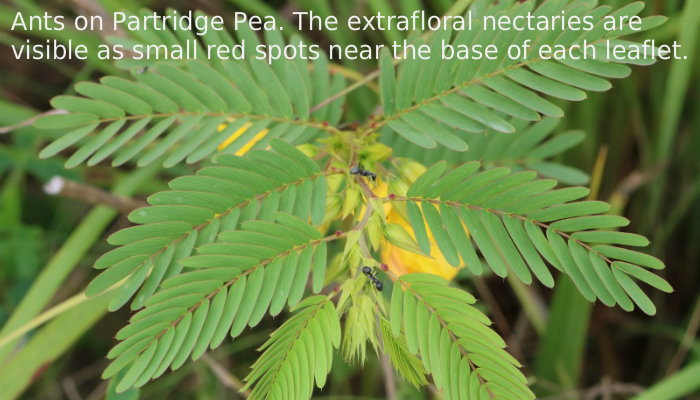Free Nectar? Don’t Mind If I Do!

Most people are familiar with the mutually beneficial relationship between plants and pollinators: plants offer up nutritious nectar or pollen to entice insects, birds, or small mammals to assist in their (ahem) sexual reproduction. Sure, in some cases the plants cheat and trick a bee into “mating” with a flower that resembles a female bee with no nectar or pollen provided, or a tricky bee will snip into a flower’s base to drink the nectar while avoiding its pollen-laden anthers. But for the most part, it’s a convenient system for both plants and pollinators.
Some plants, however, have a secret stash of nectaries tucked away on their stems or leaves. These little pots of sweetness offer up nectar to insects, apparently without a catch. Ants or flies may wander the leaves, sipping nectar, and going nowhere near the flowers. It’s obvious what the insects get out of this–but how does it benefit the plant?
The most likely advantage plants derive from extrafloral nectaries is protection. Ants and other insects that avail themselves of the nectaries will, in the defense of their wonderfully nutritious and low-effort food source, drive off or deter more harmful herbivores that may attempt to feed on the plants themselves.
I first learned of “extrafloral nectaries” when researching the partridge pea, which has fairly large nectaries on its leaves that are easily visible by the naked eye. Its foliage is often crawling with ants and other small insects, and if you watch closely you can see them pausing at the little nectar pots.
When I observed an ant on the leaves of Illinois bundleflower, another plant in the legume family like the partridge pea, I wondered if it, too, had extrafloral nectaries to lure insects as a protective squad. I examined the leaf but was unable to find any obvious pots like the partridge pea had. Research online confirmed that the Illinois bundleflower did indeed have extrafloral nectaries, so I was determined to find them.
First I staked out a patch of bundleflower and watched the ants and flies going about their business. They seemed to wander aimlessly up and down the stems and leaves, but often paused at the petioles, where the compound leaves joined the stem. Armed with an idea of where to focus my search, I collected a stem to bring home for a closer look (doing my best to de-ant it before bringing it inside, with limited success).
It didn’t take long at all, with a little extra magnification, to find tiny little nectar pots right at the base of the leaves, where the ants had paused in their journeys. Just a tiny round opening with a drop of nectar within, there for the taking by any passing invertebrate, no questions asked.
What other plants are harboring these secret sweets? You can bet I will be keeping a closer eye out for ants among the leaves.
Originally posted on Sycamore Greenway Friends


